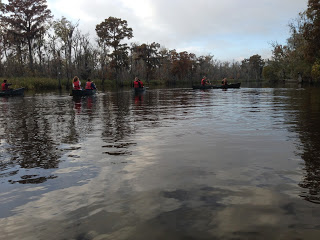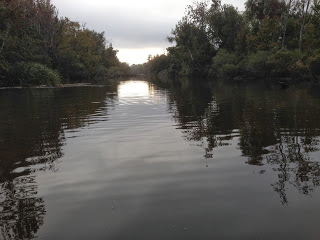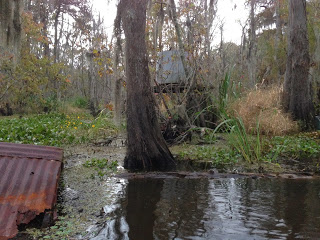Literature

This past Friday I went canoeing with the Environment Program at Loyola, an excursion lead by my biology colleague David White.
We drove in vans west out of New Orleans, to where I55 heads north toward Memphis. On a narrow stretch of land and between Maurepas Swamp and Lake Pontchartrain, we pulled off the frontage road and loaded into twelve canoes. As we set out, we had to paddle under the elevated highway. This was a strange, fantastical experience: to be slipping through the shimmering calm water, past enormous concrete pilings as cars and trucks went hurtling by twenty or so feet above.
Making our way into Shell Bank Bayou, we paused to discuss the invasive Triadica sebifera (Chinese tallow or "popcorn" trees) that grow along the boggy edges of the water. David explained how they were imported as ornamental plants (they are in the same family as the seasonally available, flashy red poinsettia), and how their waxy seed casings serve as food for various bird species. The birds, having eaten the outer husks, let the seeds themselves drop all over?and over time, spreading these trees everywhere. Their seeds can lay dormant in the ground for up to seven years...waiting until a storm knocks down grown trees, allowing direct sunlight to hit the ground, whereupon the seeds finally germinate.

The water moved around us gently but steadily?it's still water, yet there are weird currents: you'd notice it when clumps of spinning water hyacinths would come barreling by, drawn somewhere into the bayou faster than the canoe. Deeper into the bayou, we came across the rusted metal structure of an old fishing camp?another reminder of the human presence that helped shape this landscape.

As night fell, we all formed a loose flotilla in a dense marshy area surrounded by cattails and cypress stands. David gave a brief talk on "landscape ecology," touching on the "idea of wilderness," crepuscular species, noise pollution, sensory overload, and how our bodies become more relaxed out here. It was really great: everyone quietly slapping and shooing away the mosquitoes that were suddenly swarming us, but still listening?relaxing. We could hear the shush of the highway in the distance, and the eerie hoot-hoots of owls as they swooped through the cypress trees.
What really stuck with me was David's mention of scale as a key landscape-ecological term, and it made me think about what we have been doing in my Literature & Environment courses this semester.
For instance, last week when we discussed Brenda Hillman's poem "Symmetry Breaking" (from Loose Sugar), we looked at how the lines shift scale as the air traveler speaker reflects on various parts of the cosmos that assert themselves as her plane cruises above the north American continent. The focus moves from the airplane meal in front of the speaker, the "chicken with / the flap of itself on top" and the "triangle of Cool Whip", to the vast landscape of Utah unfurling out the window, and even to the universe in some distant moment when it "said goodbye to evenness." The poem ponders the bizarrely workaday airline food and airport rituals while also assessing vast reaches of time and space?we are presented with overlapping and interpenetrating 'landscapes' that foreground different forms of life and non-life. We can't be too quick to deem which came 'first' or determine what is the more 'natural' here; instead, we are called on to consider closely the patterns of movement and behavior at different levels, from "cell division" to the "dinner roll."

During his talk about landscape ecology, David talked about certain places like the Grand Canyon, where the idea of wilderness is more palpable; but he said even when camping there, he recalled seeing the flashing lights of jets 30,000 feet above. I remember this experience too?being at the bottom of the canyon, lying next to the rumble of Hermit Rapids at night, and seeing the tiny blink blink blinks way above me. This is like an inverted version of Brenda Hillman's poem, with the riparian ecosystem in the foreground and the little interior world of the airliner far removed, but nevertheless weirdly present. These are some of the things that landscape ecology considers: the distances and gaps between things, and yet the connections and overlaps, where they exist?and how these can change over time. It's a way of thinking about processes on multiple scales, at once.
Heading home, we passed again beneath the towering strip of highway, and it was even more surreal in the pitch black of night?the aerial headlights and warped whooshes like some ongoing alien enterprise bisecting the bayou. Or maybe we were the aliens: David had told us that as we paddled back to the launch site we would be overwhelmed by the sounds of the highway, and he was right. It was hard to imagine that we'd soon be on a similar corridor, rushing back to New Orleans through the night.
- Canoeing, A Brief Personal History
In the canoe last summer, on the big lake Rumor has it that there were four water rescues out in Lake Michigan last week. At least, four near where I am, on the Leelanau peninsula. The big lake is big, and can go from glassy calm to six-foot swells in...
- River Notes
As I've been spending more time standing in and walking along the Mississippi River on recent mornings, I've also been thinking back to an earlier time in my life when I worked as a river guide in Wyoming for a couple summers, toward the end...
- Morning Walk Photo Essay Ii
It was about a year ago that I posted my first morning walk photo essay; I figured today that it was time to post a second one. (I find myself telling students that things become so much more interesting when you do them multiple times?like reading,...
- Notes On Evacuating
Last night at this time I was building a model of our home out of Legos, showing my two-year-old roommate Julien how we had prepared for the storm: how we had boarded up the vulnerable back window, and how the wind would slam into the house and whip around...
- Petoskey Stones: Decorative Objects, Hyperobjects
Shortly into Ernest Hemingway's "Ten Indians," one of the Nick Adams stories, we read the following paragraph: They drove along. The road turned off from the main highway and went up into the hills. It was hard pulling for the horses and the boys...
Literature
Landscape Ecology
This past Friday I went canoeing with the Environment Program at Loyola, an excursion lead by my biology colleague David White.
We drove in vans west out of New Orleans, to where I55 heads north toward Memphis. On a narrow stretch of land and between Maurepas Swamp and Lake Pontchartrain, we pulled off the frontage road and loaded into twelve canoes. As we set out, we had to paddle under the elevated highway. This was a strange, fantastical experience: to be slipping through the shimmering calm water, past enormous concrete pilings as cars and trucks went hurtling by twenty or so feet above.
Making our way into Shell Bank Bayou, we paused to discuss the invasive Triadica sebifera (Chinese tallow or "popcorn" trees) that grow along the boggy edges of the water. David explained how they were imported as ornamental plants (they are in the same family as the seasonally available, flashy red poinsettia), and how their waxy seed casings serve as food for various bird species. The birds, having eaten the outer husks, let the seeds themselves drop all over?and over time, spreading these trees everywhere. Their seeds can lay dormant in the ground for up to seven years...waiting until a storm knocks down grown trees, allowing direct sunlight to hit the ground, whereupon the seeds finally germinate.
The water moved around us gently but steadily?it's still water, yet there are weird currents: you'd notice it when clumps of spinning water hyacinths would come barreling by, drawn somewhere into the bayou faster than the canoe. Deeper into the bayou, we came across the rusted metal structure of an old fishing camp?another reminder of the human presence that helped shape this landscape.
As night fell, we all formed a loose flotilla in a dense marshy area surrounded by cattails and cypress stands. David gave a brief talk on "landscape ecology," touching on the "idea of wilderness," crepuscular species, noise pollution, sensory overload, and how our bodies become more relaxed out here. It was really great: everyone quietly slapping and shooing away the mosquitoes that were suddenly swarming us, but still listening?relaxing. We could hear the shush of the highway in the distance, and the eerie hoot-hoots of owls as they swooped through the cypress trees.
What really stuck with me was David's mention of scale as a key landscape-ecological term, and it made me think about what we have been doing in my Literature & Environment courses this semester.
For instance, last week when we discussed Brenda Hillman's poem "Symmetry Breaking" (from Loose Sugar), we looked at how the lines shift scale as the air traveler speaker reflects on various parts of the cosmos that assert themselves as her plane cruises above the north American continent. The focus moves from the airplane meal in front of the speaker, the "chicken with / the flap of itself on top" and the "triangle of Cool Whip", to the vast landscape of Utah unfurling out the window, and even to the universe in some distant moment when it "said goodbye to evenness." The poem ponders the bizarrely workaday airline food and airport rituals while also assessing vast reaches of time and space?we are presented with overlapping and interpenetrating 'landscapes' that foreground different forms of life and non-life. We can't be too quick to deem which came 'first' or determine what is the more 'natural' here; instead, we are called on to consider closely the patterns of movement and behavior at different levels, from "cell division" to the "dinner roll."
During his talk about landscape ecology, David talked about certain places like the Grand Canyon, where the idea of wilderness is more palpable; but he said even when camping there, he recalled seeing the flashing lights of jets 30,000 feet above. I remember this experience too?being at the bottom of the canyon, lying next to the rumble of Hermit Rapids at night, and seeing the tiny blink blink blinks way above me. This is like an inverted version of Brenda Hillman's poem, with the riparian ecosystem in the foreground and the little interior world of the airliner far removed, but nevertheless weirdly present. These are some of the things that landscape ecology considers: the distances and gaps between things, and yet the connections and overlaps, where they exist?and how these can change over time. It's a way of thinking about processes on multiple scales, at once.
Heading home, we passed again beneath the towering strip of highway, and it was even more surreal in the pitch black of night?the aerial headlights and warped whooshes like some ongoing alien enterprise bisecting the bayou. Or maybe we were the aliens: David had told us that as we paddled back to the launch site we would be overwhelmed by the sounds of the highway, and he was right. It was hard to imagine that we'd soon be on a similar corridor, rushing back to New Orleans through the night.
- Canoeing, A Brief Personal History
In the canoe last summer, on the big lake Rumor has it that there were four water rescues out in Lake Michigan last week. At least, four near where I am, on the Leelanau peninsula. The big lake is big, and can go from glassy calm to six-foot swells in...
- River Notes
As I've been spending more time standing in and walking along the Mississippi River on recent mornings, I've also been thinking back to an earlier time in my life when I worked as a river guide in Wyoming for a couple summers, toward the end...
- Morning Walk Photo Essay Ii
It was about a year ago that I posted my first morning walk photo essay; I figured today that it was time to post a second one. (I find myself telling students that things become so much more interesting when you do them multiple times?like reading,...
- Notes On Evacuating
Last night at this time I was building a model of our home out of Legos, showing my two-year-old roommate Julien how we had prepared for the storm: how we had boarded up the vulnerable back window, and how the wind would slam into the house and whip around...
- Petoskey Stones: Decorative Objects, Hyperobjects
Shortly into Ernest Hemingway's "Ten Indians," one of the Nick Adams stories, we read the following paragraph: They drove along. The road turned off from the main highway and went up into the hills. It was hard pulling for the horses and the boys...
